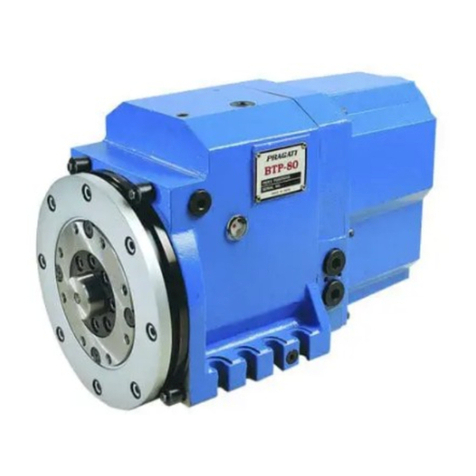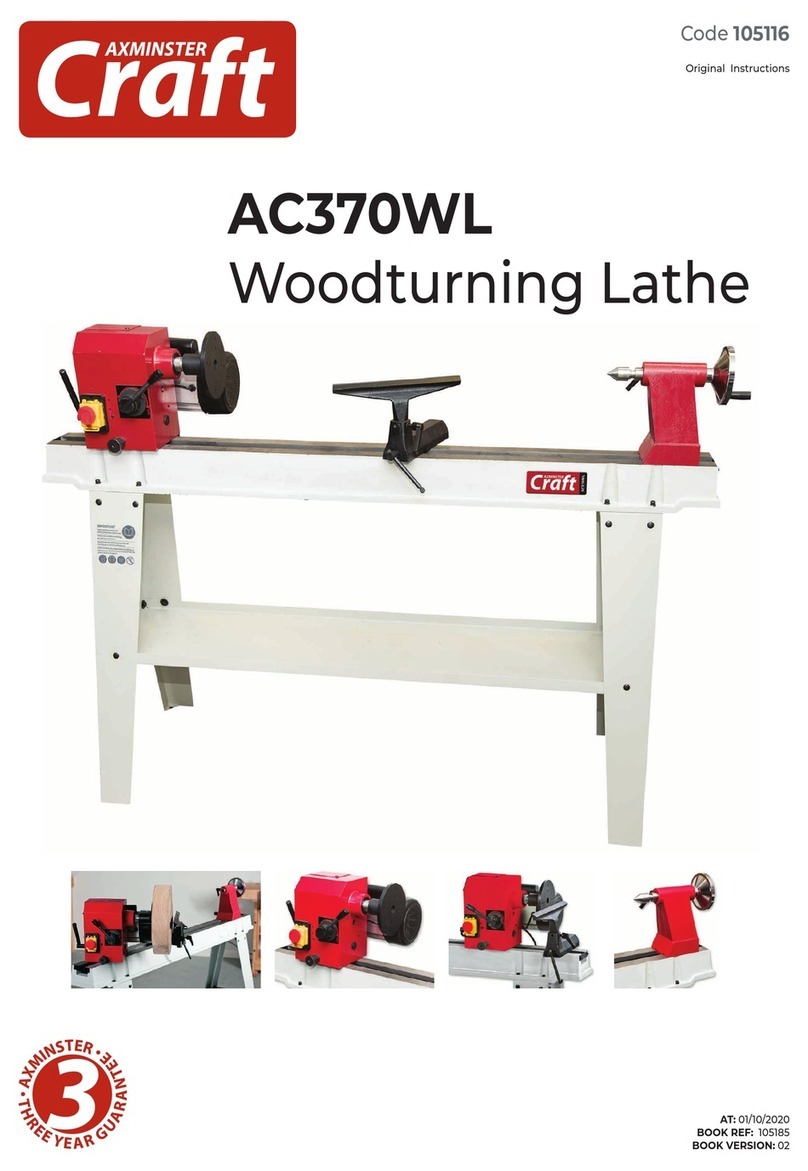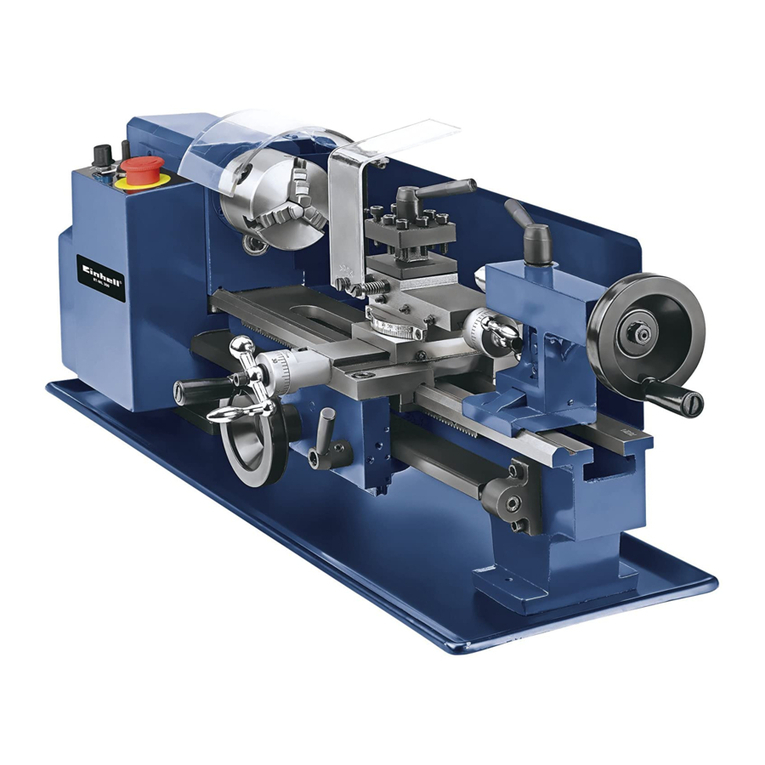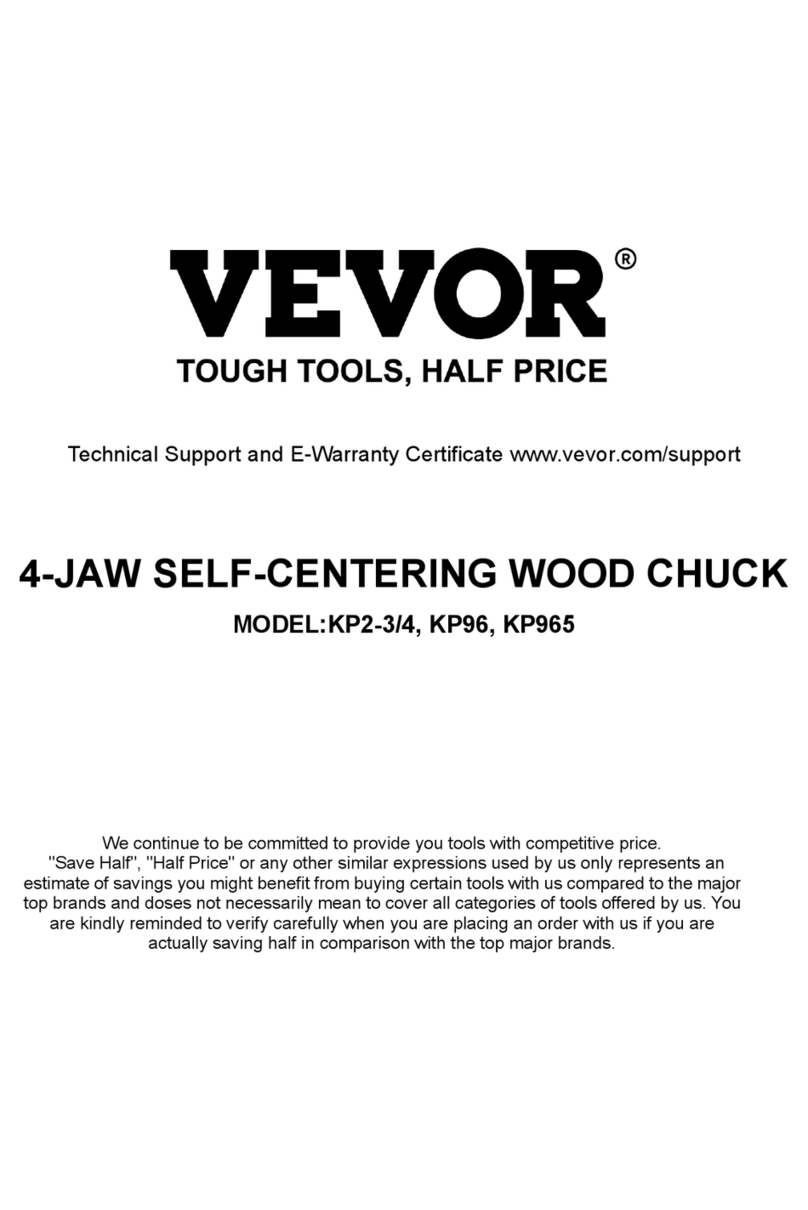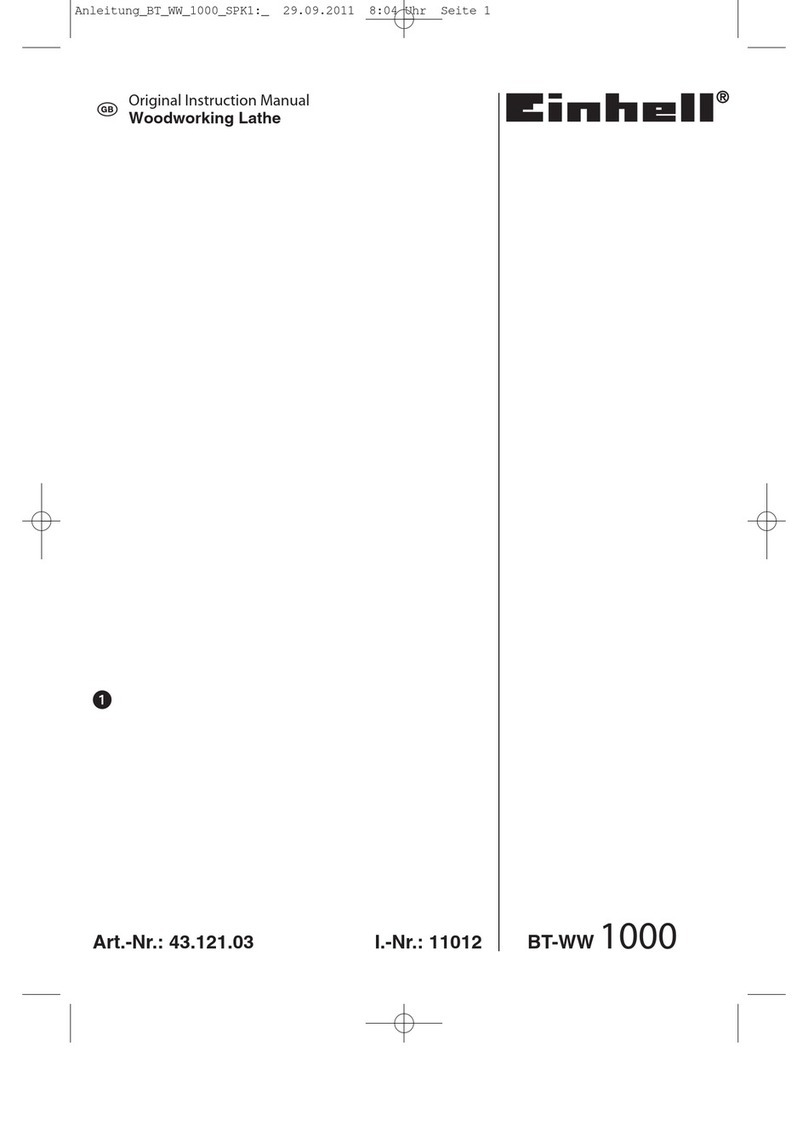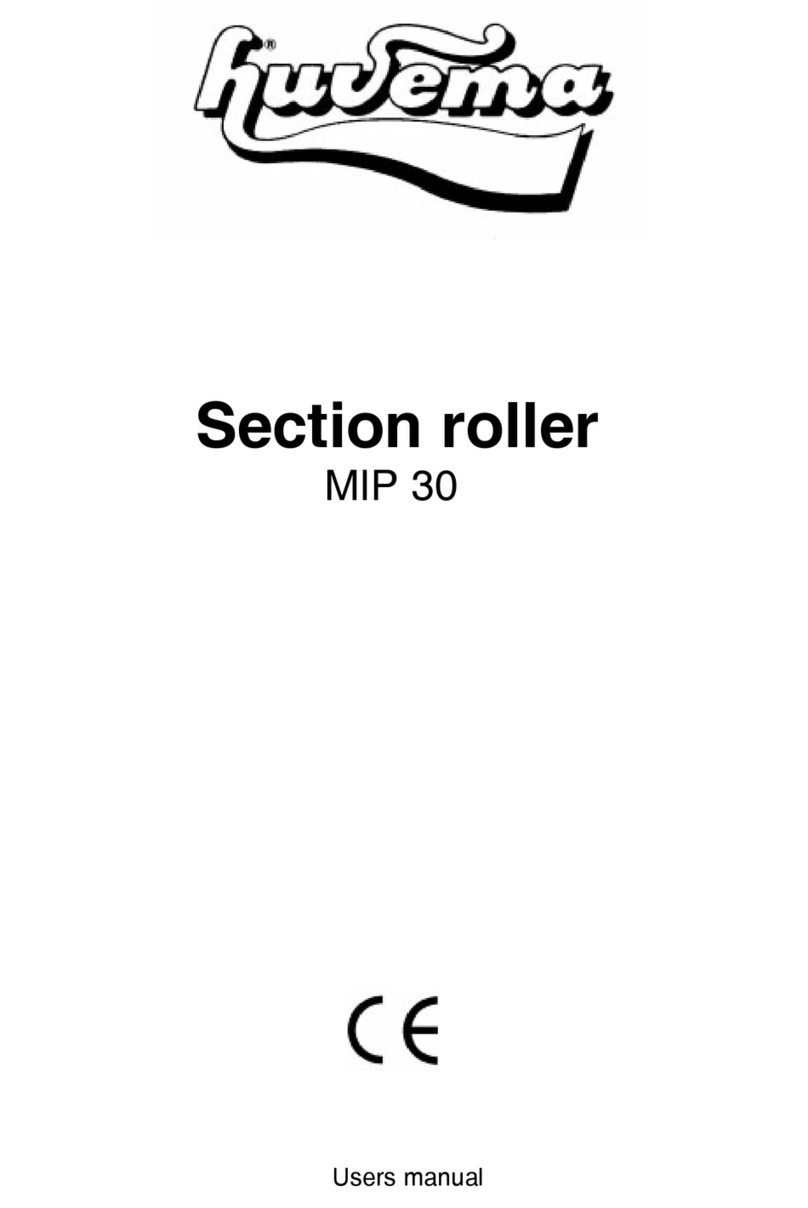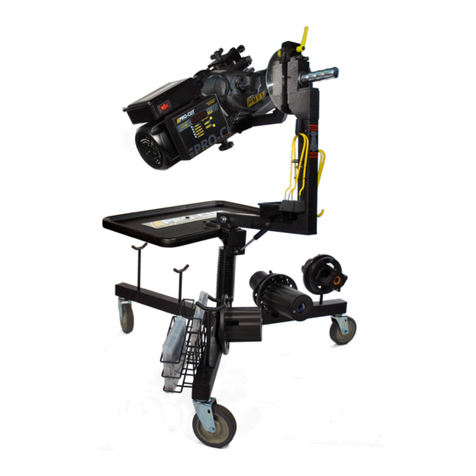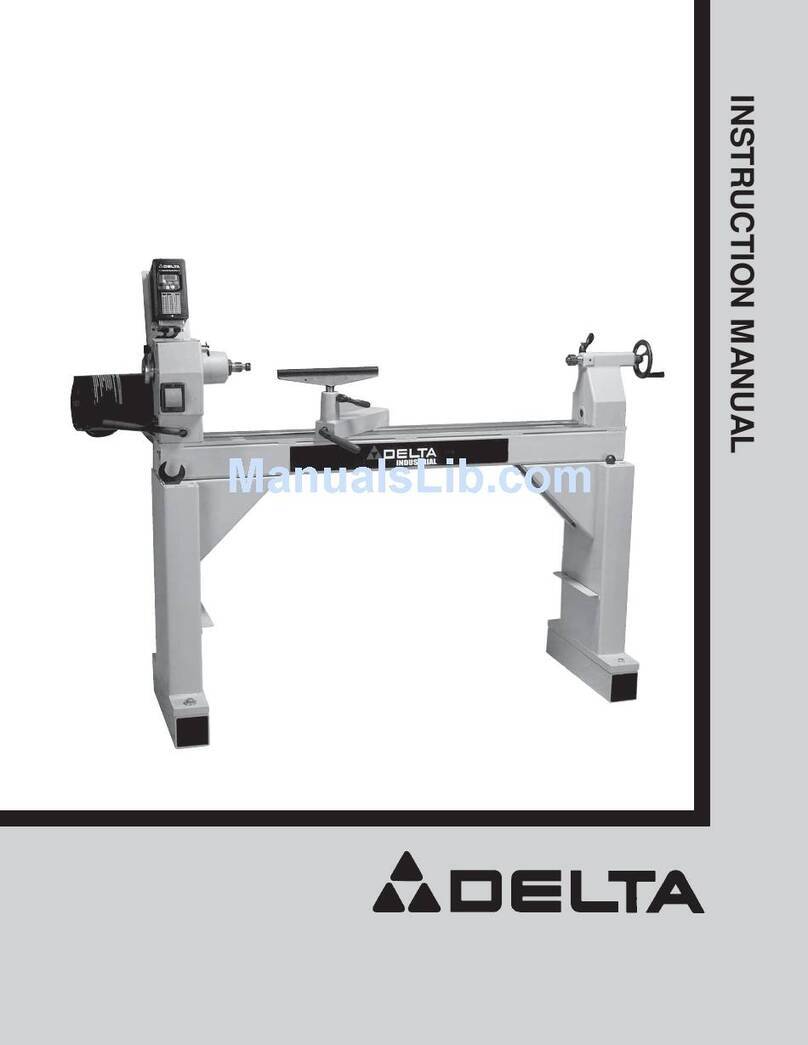Pragati BTP-50 User manual

BI-DIRECTIONAL
TOOL TURRET
INSTRUCTION MANUAL
B T P - 50
March - 2011


1. TURRET IDENTIFICATION 5
2. TECHNICAL INFORMATION 6
2.1 Principle of Working 6
2.2 Special features 6
2.3 Technical and Dimensional details 7
3. INSTALLATION 8
3.1 Fitment on the machine 8
3.2 Coolant system 8
3.3 Fitment of the Tool disc 9
3.4 Electrical connections 9
3.4.1 Motor wiring details 9
4. TECHNICAL INFORMATION 12
5. MAINTENANCE 15
5.1 Lubrication 15
5.2 Hand cranking 15
5.3 Adjustment of Ringfeder Clamp 16
6. REPLACING COMPONENTS 17
6.1 Replacement of Rotary encoder 17
6.2 Replacement of Proximity switch 18
6.3 Replacement of Coolant Valve Button (Poppet) 19
7. ASSEMBLY DRAWINGS 20
8. COMPONENT LIST 23
9. INSTRUCTIONS FOR DIS-MANTLING 25
10. INSTRUCTIONS FOR ASSEMBLY 26
11. FAULTS AND CORRECTIVE ACTIONS 30
AUTOMATIC TOOL CHANGER
BI-DIRECTIONAL TOOL TURRET - March - 2011
Index
BI - DIRECTIONAL TOOL TURRET BTP - 50
3


5
BI-DIRECTIONAL TOOL TURRET - March - 2011
AUTOMATIC TOOL CHANGER
1. Turret Identification
1.1 Turret Name Plate Details
Fig 1.0
Model
Identification
Turret serial number Electric
supply
MADE IN INDIA
Rear mounting
Position
Front mounting
Position
(operator side)
FIG 1.2
1.3 Mounting position:
Coolantvalvepositionofturretdependsonthemountingposition;FrontorRear. If not specified Rear
mountingisstandard.
1.2 Model Identification
Model
Fig 1.1
Ordering sample : BTP - 50 Turret , 8 Station, Rear mounting, 415V , 3 Ph motor
BTP - 50 - 8 - R - 415
63
80
100
125
160
No.Ofstations
8 stations 8
12 stations 12
Mounting
F - Front
R - Rear
Default Values :
No. Of stations - 8
Mounting position - R
Motor Voltage - 415
Frequency - 50/60 Hz
BTP
Size
50 Motor voltage, 3 Phase
Range VAC
Specification
380 - 440 415
210 - 230 220
100 - 120 110

6
BI-DIRECTIONAL TOOL TURRET - March - 2011
AUTOMATIC TOOL CHANGER
2 TECHNICAL INFORMATION
2.1 Principle of working
2.2 Special features
1. Cam Shaft
2. Follower Shaft 3. Disc Spring 4. Sliding Coupling
5.Fixed Coupling 6.Indexing Coupling7.Drum Cam 8. Torque Motor
9. Proximity Switch 10.Encoder
Fixed coupling (5), Indexing coupling (6) and sliding coupling(4) form a set of 3 piece coupling. Axial
movement of 3 piece coupling is controlled by drum cam (7). Movement of indexing coupling (6) is
controlled by parallel index mechanism(1) and (2). Torque motor(8) drives the cam shaft (1) through a
system of gears. Cam shaft indexes the follower shaft (2) through a "Parallel index" drive mechanism.
Cam is also geared to the "Drum cam" (7) which controls clamping and release of the 3-piece coupling.
One revolution of cam shaft completes one indexing cycle of "de-clamping-indexing-clamping"
Absolute Position encoder gives feedback of the turret position. Proximity switch checks the clamped
positionofthe turret.
* Three-Piece, face gear coupling allows the tool disc to be indexed without lifting. It also ensures
high repeat positioning accuracy and rigidity
* Parallel index Cam mechanism allows fast and smooth indexing of heavy tool discs. Computer
generated cam profiles ensure shock free indexing action.
* Totally enclosed ,Robust mechanism with oil bath lubrication.
* Electrical elements conveniently located in a separate area, Free from oil and coolant.
* Bidirectional working can index in either direction to allow shortest indexing time.
Fig - 2
1
2
3
4
5
6
7
8
9
10

7
BI-DIRECTIONAL TOOL TURRET - March - 2011
AUTOMATIC TOOL CHANGER
2.3 Technical and Dimensional details
Fig 2.2
TECHNICAL SPECIFICATIONS
Model BTP- 50
Centre height mm 50
snoitisopxednifo.oN 21ro8
noitatstnecajdarofemiTgnixednIlatoT )°54ro°03( ces 35.0
).xam(gnilooTdnacsidlooTfoaitrenI ²m.gk .0
).xam(gnilooTdnacsidlooTfothgieW gk 15
).xam(ycneuqerfgnixednI nim/1 21
ycaruccAgninoitisoptaeR ged °21±
ycaruccAgnixednI ged °6±
thgiewlatoT gk 18
1. 1/4” BSP coolant inlet from either side. 2. Coolant Ring can be clamped to indexing coupling at a suitable
angular position. 3. Alternative positions of coolant valve 4. Adjustment range for coolant outlet valve. 5. ½’
BSP electrical connection from either side. 6. Tool disc. 7. Reference pin for tool disc if required. (To be
removed after alignment and clamping of tool disc).
25
NYTICAPACGNIDAOL m
RX1F 004
RX1F 601
RX1F 053
1
5
4
8
23
7
6REFER
DETAIL - C
DETAIL - C
INDEXING FLANGE
COOLANT FLANGE
O - RING
For Bolt size M8
For Bolt size M8
PRAGATI
BTP - 50
MADE IN INDIA
140
85
25
15g6
15 107
15 35
316 266 137 22 64 64
128
18 +0.1
0
50 170
0
20
70
121
0
20
70
16
25H6/h5
Alternate positions
of Alignment pin
60 22
15
110
109

8
BI-DIRECTIONAL TOOL TURRET - March - 2011
AUTOMATIC TOOL CHANGER
3. INSTALLATION
3.1 Fitment on the machine
Turret has the two alternative positions for the coolant entry. Coolant outlet is at two valves position, '1 and 2 '
located on the coolant ring as in the figure. Spring loaded poppet valve (fig 3.1.2) is fitted on the working position;
and other entry position is blocked by the plug (28)
3.1a Procedure for adjustment :
Turret main
body
M8x50L
63+0.1
Falt seating
surface
Turret base
Machine
Fig 3.0
Turret shouldbealignedbydialingsurfaceoftheindexingflange.
Clamping bolts should be tightened after aligning the seating
surface,squaretothelatheaxis.
Clamping bolts should use machine washers of extra thick-ness
(min.5mm)toensureproperclamping.
Dowel Pins are not recommended for ensuring the alignment
of turret. It is preferable to allow the turret to slip in the event
of an accidental shock or overload. This slipping absorbs some
of the energy of the shock and reduces the possible damage.
Turret can again be brought back to alignment by dialing a
referencesurfaceonthetooldisc.
There is one more reason for avoiding the dowel pin. Accidental collisions are not uncommon in the field of
CNC lathes. In the event of a collision, dowel pins can get sheared or damaged. It is a difficult task to remove
such dowel pins, and to fit new ones. New dowels may involve enlarging the damaged hole by drilling and
reaming. This is difficult to do at the customer's place. This is a difficult operation to be done on site, and is
most likely to be less than perfect. On the other hand, it is perfectly possible to use the turret and tool disc
without the use of dowels. The friction joint can easily take up normal cutting loads, including occasional over
loads.
Pragati turrets, therefore, do not have a provision of dowelling the body to the base.
Both the coolant ring and coolant flange have provision for angular adjustment. Coolant flange should be adjusted
to align the 'O' Ring (20) with coolant passages on tool disc. Coolant ring angle should then be adjusted by the
same angle to align the coolant valve with a hole in coolant flange. This can be done by aligning the marker lines
onthese components.
3.2 Coolant system
FIG 3.1
VIEW WITH FRONT COOLANT FLANGE REMOVED.
COOLANT ENTRY POSITION
AVAILABLE ON OPPOSITE SIDES.
COOLANT EXIT
COOLANT FLANGE
(14)
COOLANT RING (17)
1
2
Insert suitable rod and use
it as a handle for the
adjustment of angular
position of Coolant ring
CLAMPS (15)
Angle α
depends on
the tool disc
design
α
O - RING (20)
FIG 3.1a
CUT SECTION AT 1
20
28
26
FIG 3.1b
CUT SECTION AT 2
5
18
19
14
17
21
130 129 24 1

9
BI-DIRECTIONAL TOOL TURRET - March - 2011
AUTOMATIC TOOL CHANGER
3.3a Tool Disc Mounting Details for BTP 50
3.3 Fitment of Tool Disc on Turret :
Mounting surface of the tool disc must be flat.
Any flatness error should be concave. IfTested with blue, Colour should be all over, Or on outside part of contact
area.Tool disc is to be fitted on the indexing flange with the help of clamping bolts, and machine washers. Disc
should be angularly adjusted within the clearance of the bolt holes, to get the correct centre height of the tool. It
should then be firmly clamped by tightening the bolts.
If Dowel Pins are Required, it should be placed at a Radius of 45mm (fig 3.2b ).
0.005/100
FIG 3.2b
φφ
φφ
φ90
20mmMax.
DEPTH
φφ
φφ
φ10g6
Dowel
pin
TOOL
DISC
FIG 3.2a
BOLT SIZE
M8 X 35 - 8No.S
EXTRA
THICK
WASHERS
TOOL
DISC
φφ
φφ90
0.005/100
17
14
Turret mounting
base
αmax = ± 20°
R
For Dowel Pin φ8g6,
Max. Depth = 16mm
at PCD 70
φφ
φφ
φ70
For Mounting
bolts M8
Coolant entry Point
in to Tool Disc
at angle α°
FIG 3.3
0.005/100

10
BI-DIRECTIONAL TOOL TURRET - March - 2011
AUTOMATIC TOOL CHANGER
3.4 Details of Electrical Connections
1. Torque Motor 2.Thermal switch 3. Absolute Encoder 4. Proximity Switch
FIG 3.4
1(2)
4
3
1
2
3
4
5
6
7
8
9
10
11
3 ~ U
V
W
E
T
T
WIRING DETAILS FOR BIDIRECTIONAL TOOL TURRET
ON TNENOPMOC REBMUNSCITSIRETCARAHC LI
A
TED ZISERIW
1ROTOMEUQROT
SEGATLOVEVITANRETLA ESAHP3CAV022DNA083,514 SEICNEUQERFEVITANRETLA zH06DNAzH05 REWOPETUCRICTROHSROTOM AVK2.136-PTBROF
²mm57.0
2HCTIWSLAMREHT CAV514A2°031 TCATNOCDESOLCYLLAMRON ²mm2.0
3REDOCNEETULOSBA
%01ELPPIRCDV03-51
)YLPPUS(Am053
)DOAL(LENNAHC/Am05
PNP-TUPTUO
²mm2.0
4HCTIWSYTIMIXORP PMALCTERRUT( )LANGIS
%01ELPPIRCDV03-01
)DAOL(Am002
ON-PNP-TUPTUO
²mm2.0
R-PHASE
Y-PHASE
B-PHASE
EARTHING
BIT 1
BIT 2
BIT 3
BIT 4
STROBE
PARITY
0 VOLTS
24 V DC
OUT PUT
0 VOLTS
24 V DC
S E

11
BI-DIRECTIONAL TOOL TURRET - March - 2011
AUTOMATIC TOOL CHANGER
3.4.1 Electrical motor wiring details
USE FUSE RATING ABOUT THREE TIMES MOTOR
CURRENT. (MINIMUM 6A FUSE TO BE USED
)
MOTOR CURRENT (Amps)
LEDOM
CAEGATLOV
/514 083 022 011
50-PTB 6.1 0.3 0.5
MF
TC MR SSR1 SSR2
MF
MR 0 V
0 V
24 VDC
E
T
T
MMM
MR
TC
TC
MF
TC
Q 4. 0 . Q1 4I 3. 1
OUTPUT
INPUT
PROGRAMABLE CONTROLLER (PLC)
MOTOR
3 ~
FUSES
R
Y
B
N
E
TORQUE MOTOR
FORWARD REVERSE SOLID STATE
RELAYS
THERMAL RELAY
130º C
NORMALLY CLOSED
415 VAC 2A
SSR
415 VAC 25 A
FIG 3.5
WIRING DIAGRAM FOR MOTOR
MOTOR
FORWARD MOTOR
REVERSE
FAULT
SIGNAL
The figure shows recommended wiring diagram Turret.
Please note that only 3 phase motor with thermal relay is part of
Turret supply.
1. Solid state relays are required to switch off the motor in shortest
possible time
2. Thermal relay should directly switch off the motor.

12
BI-DIRECTIONAL TOOL TURRET - March - 2011
AUTOMATIC TOOL CHANGER
Following points should be noted while selecting control system for turret :
1. Direction of rotation motor for shortest indexing time is to be decided by control system.
2. Indexing times of these turrestare short. It is necessary to select particularly fast PLC (programmable logic
controller) for the control of turret operations.
3. Referring to the signal diagram, value ofT3 is particularly critical. Motor must come to a physical halt within
this time. Otherwise, the turret will get de-clamped and the Turret clamp signal will be lost.
Following measures are suggested for stopping the motor in minimum possible time.
a. Control should be capable of detecting the Turret clamp signal within 3 to 6 ms.
b. Solid state relays should be incorporated in the motor circuit to ensure fastest possible disconnection.
Regular contractors can be used for motor direction selection, followed by solid state relays, at least in
two phases.
TURRET
CLAMP
SWITCH
1
0
1
0
1
0
1
0
1
0
1
0
1
0
T1T 2
1
0
1
Oº 180º 360º 360º
180º
POSITION 4 POSITION 5
TURRET CLAMP
POSITION 3
START
T3
CAM ANGLE
MOTOR
Bit 1
Bit 2
Bit 3
Bit 4
STROBE
PARITY
ENCODER
FIG 4.0 100ms 75ms
4. TECHNICAL INFORMATION
4.1 Electrical signals
CW
ENCODER SIGNALS
POSITION NUMBER
CCW
BIT 1
BIT 2
BIT 3
BIT 4
STROBE
PARITY
1 2 3 45678 9 10 11 12
0
0 0 0 0 0 0
00000
000
0 0 0 0 0 0 0
0
00
000
0 0 0 0
1 1 1 1 1 1
111111
1 1 1 1 1
11111
111111111111
1 1 1 1 1 1

13
BI-DIRECTIONAL TOOL TURRET - March - 2011
AUTOMATIC TOOL CHANGER
4.2 Flow chart for turret control
FIG 4.1
NOTE : MONITOR TURRET CLAMP SWITCH SIGNALON CONTINUOUS BASIS. GENERATE FEED -HOLD
IF CLAMP SIGNAL MISSING
START
POSITION ‘X’
DEMAND
POSITION ‘Y’
DEMAND
VALID ?
1<Y<N
NO ALARM INVALID
TOOL DEMAND
NO
YES
X = Y
YES
START 4 SEC
TIMER T4
YES
NO
X < Y
YES
(X=Y) < N/2 NO (X=Y) < N/2 NO
YES
YES
START TORQUE
MOTOR ‘CCW’ START TORQUE
MOTOR ‘CW’
TURRET CLAMP
SWITCH OFF ?
YES
NO
A
E
D
D
E
T4 > 4SEC
YES
NO
‘TIME FAULT’
ALARM
END
CYCLE COMPLETE
SIGNAL
YES
NO
YES
NO
A
TURRET CLAMP
SWITCH ON ? TURRET NOT
LOCKED ALARM
POSITION FAULT
ALARM
X=Y
DELAY T5 msec
STOP MOTOR
DELAY T5 = T3+5 msec
TURRET CLAMP
SWITCH
ON
NO D
E
E
D
B
X=Y NO
YES
YES
“N” = NUMBER OF INDEX POSITION 80, 12 OR 24

14
BI-DIRECTIONAL TOOL TURRET - March - 2011
AUTOMATIC TOOL CHANGER
4.3. Requirements of turret control :
4.3.1 Sequence of operation :
4.3.2 control system :
* Select a particularly fast PLC (programmable logic controller) for the control of turret operation.
* Control should be capable of detecting the turret clamp switch signal within a period 5 ms.
* Motor should be switched off by solid state relays. Contractors take much longer time (30 to 40 ms).
Suggested electrical circuit is on page 12.
4.3.3 SAFETY INTERLOCKS :
A. 'MOTOR OVERHEAT' signal
Thermal Switch has been provided in the motor winding to give indication of motor overheating. In the event of
overheating relay should trip the motor contactor, and also give ‘Motor overheating’signal to the control circuit.
Motor contactor should be tripped without depending on PLC software.Typical circuit diagram is given in page
12.
B. 'TIME FAULT'’signal
Timerequired forindexingthrough180° isbetween 1.3secondsto 3.1secondsdependingon theTurretmodel.
This is the maximum time required for completing the indexing operation. If the ‘cycle complete’ signal is not
received even after this time, this will be an indication of some fault in the indexing cycle. Control circuit should
beprogrammed togive a‘TimeFault’signal, ifthe‘Cycle complete’signal isnot received withina specifiedtime
(say 1 second more than the maximum expected time) after the ‘Cycle Start’ signal.
C. 'TURRET NOT LOCKED' signal .
Turret clamp signal should be continuously monitored. If the clamp signal is missing, a Feed Hold signal should
be generated to stop the machine movements. Simultaneously, ‘Turret not Clamped’ alarm signal should also
be generated.
D. 'POSITION FAULT' signal
At the end of indexing cycle, a check should be made to ensure that the turret has indexed to the demanded
position. If the actual position and demanded position do not match, then ‘Position fault’ alarm should be
generated.
E. 'INVALID DEMAND' signal
An eight position turret cannot react to a tool demand other than 1 to 8. If any other tool position (say 12) is
demanded, the control should give 'INVALID DEMAND' Message.
All these signals should stop the operation of the machine, and an indication should be available on the control
panel regarding the nature of the fault.
F. MANUAL MODE OF TURRET CONTROL
Controlpanelshould havea facilitytochange overthe turret controlto manualmode.Following facilitiesshould
be available in this mode :
G. ’INCHING’ THE MOTOR IN EITHER DIRECTION :
During servicing, it is sometimes necessary to rotate the motor forchecking the functioning of the turret mecha-
nism. Push button switches should be provided to allow ‘inching’ of the motor in either direction.
H. TOOL INDEXING CYCLE ON MANUAL DEMAND :
Control system should provide a facility to index the turret into desired position by manual data entry of ‘tool
demand’. This can be either by a ‘thumb wheel’switch, or by push button data entry through CNC panel.
Indexingcycle throughmanual tooldemand willbe identicalto thenormal indexingcycle, except forthe factthe
cycle will start even if initial signal conditions are not satisfied.
Turret can stop in an un-clamped position, if the power fails during the indexing cycle. It is then possible that
valid encoder feedback is not available because the turret has stopped in an intermediate position. In such a
case, in MDI mode, the control should choose a fixed direction of motor rotation (i.e. default direction) and then
index the turret to demanded position.
Flow chart on the page 14 gives the details of operation sequence. Following general points should be
noted while selecting the control system and its program.

15
BI-DIRECTIONAL TOOL TURRET - March - 2011
AUTOMATIC TOOL CHANGER
5. MAINTENANCE
5.1 Lubrication
Procedure for hand cranking is as follows :
1. Switch off power supply to the motor.
2. Remove Back cover. Hexagon head(A/F 10) of motor shaft is now approachable.
3. Use a suitable spanner to crank the motor.
5.2 Hand cranking :
FIG 5.2
Box spanner
A/F 10 for cranking
Back
cover
FIG 5.1
DRAIN PLUG (110)
OIL FILLING PLUG (108)
OIL LEVEL INDICATOR
(109)
Turret is lubricated by medium viscosity gear box oil. Normally, oil does not require regular attention. Oil should
be changed in case the turret is opened for some reason. Use only acid- free gear box oil HLP ISO VG 46. Place
the turret on the horizontal base,And fill the oil to the level seen in oil level indicator (109). The oil filling capacity for
BTP- 50 is 0.75 liters.
Turret can be indexed by cranking the rotor of electric motor by hand. Hand cranking is required for inspecting the
setting of encoder, proximity switch and clamping function of disc springs. If turret is hand cranked through one
indexingcycle; theextra pressurecan be feltduring theclamping phase.

16
BI-DIRECTIONAL TOOL TURRET - March - 2011
AUTOMATIC TOOL CHANGER
5.3.1 Procedure for adjustment of Ringfeder clamps.
5.3 Adjustment of Ringfeder Clamps
.
FIG 5.3
114
2
115 Holes
drilled
in flange
49
48
1
45 46
59
9
Allen Key
A/F 5
Accident can happen while the turret is indexing Spurious signals in control circuit can unintentionally start
the indexing cycle, causing the turret to index in the middle of a machining operation.
In such accidents, the friction joint of Ringfeder slips and protects the internal mechanism from damage.
Such a condition is usually associated with the change in angular position of tool disc in the clamped
position or excessive noise in one direction during indexing. So, it is necessary to put back the indexing
mechanism into proper orientation by adjustment of ringfeder clamps
* Drain lube oil
* Take out Encoder (61) and mounting flange (55)
* Bring the turret to the clamped position by hand cranking, bolt ( 11 5) are in line with the holes drilled
in flange (48). In case of a 12 station turret, you may have to crank through one or two stations to get
the alignment.
* Use suitableAllen key and loosen all bolts. Slightly tap the bolt heads to release Grip.
* Crank the turret by hand and bring the turret in decamped position.
* Fit the Tool disc on the flange and force the angular movement to loosen the grip of Ringfeder clamps.
* Bring the Tool disc in proper angular position. Crank the motor and bring the turret in clamped position.
* Tighten Bolt (115) to clamp Indexing gear (10) on the spindle. Bolts should be tightened in 3 or 4 stages.
Tighten opposite bolt s in sequence 1,5,2,6,3,7,4,8.
* Crank the motor by hand in both directions and check for correct indexing movement.
* Fit flange (55) and encoder (61) back in position follow encoder mounting instructions (sec 6.1)

17
BI-DIRECTIONAL TOOL TURRET - March - 2011
AUTOMATIC TOOL CHANGER
Encoder and Drive dog Assembly
Detail - C
Alignment of encoder
with flange
Groove
on encoder
mounting
flange
Groove on
periphery
of encoder
Detail -A
Groove on periphery of encoder
Alignment of Groove on face of
encoder shaft with Drive dog
Detail - B
Groove
in line with
each othe
Sectional view
FIG 6.1b
55
62
63 C
6. REPLACING COMPONENTS
6.1 Replacement of Rotary Encoder
A
61
58
B
FIG 6.1a
FIG 6.1C
59
61
58
63
1. Mount the drive dog (58) on the encoder shaft by aligning the mark on the face of both shaft and
Drive dog (Fig 7.15a).
2. Index the Turret to any working position by hand cranking (ref sec 5.2).
3. Align the slot of the drive dog with Drive pin (59) on Main Spindle and Position the Encoder on the
Encoder mounting flange (55) (fig 6b).
4. Match the Encoder marks on its periphery with the marks of flange (55) on its face (Fig 6c).
5. Clamp the Encoder in this position using clamps ans screws (62, 63).

18
BI-DIRECTIONAL TOOL TURRET - March - 2011
AUTOMATIC TOOL CHANGER
6.2 Replacement of the proximity switch
* Bring the turret to clamped position by hand cranking.
* Take out Proximity switch assembly. Take out Threaded 'O' Ring (81).
* Measure distance 'a' and note it down for reference.
* Replace switch, and maintain distance 'a'.
* It is important to maintain the gap of 0.8 mm to1mm as shown in the figure; Detail X.
If necessary adjust 'a' to get the desired gap.
* replace the threaded 'O' Ring(81) back in position.
* Place the switch assembly back in position . Hand crank the Turret (ref page 11) and check the
function of the switch. Switch LED should light up during clamped position of turret.
FIG 6.2a
III
V
X
LEDOM tsiD
05-PTB 5.32
77
78
81
LED
79
23.5mm
for BTP - 50
GAP
0.8mm
Detail X
Proximity switch assembly
FIG 6.2b
V
80
78
75
03

19
BI-DIRECTIONAL TOOL TURRET - March - 2011
AUTOMATIC TOOL CHANGER
6.3 Replacement of Coolant valve Button (poppet).
FIG 6.3e FIG 6.3f
Main Body
Coolant Ring
Coolant Flange
Marking groove in line with
coolant flange and Coolant Ring
Marker settings for working position
Main Body
Coolant Flange Coolant Ring
Marking groove in line with
coolant Ring and Main Body
Marker Positions for replacement of Valve Poppet
Insert suitable rod and use
it as a handle for the
adjustment of angular
position of Coolant ring
Clamps for
Coolant ring
18
Coolant
flange (14)
Coolant
Ring (17)
FIG 6.3d
FIG 6.3c
FIG 6.3b
FIG 6.3a
18
5
19
14
17
21
130
129
24
20
28
26
1
21
130
22 129
Coolant poppet / button assembly
Coolant Poppet (21) rubs against coolant flange during indexing; and is liable to wear. Provision
has been to made replace the button, without removing the Tool disc from the turret.
For replacement , Loosen clamps (18), and move coolant ring to align the reference marks in line with
the corresponding mark on the body as shown in fig (fig 6.3f). Remove the Grub (26). Use M4x30
screw for removing the poppet Assembly. Change the poppet and reassemble it.

20
BI-DIRECTIONAL TOOL TURRET - March - 2011
AUTOMATIC TOOL CHANGER
7.0 ASSEMBLY DRAWINGS
With back cover and motor removed.
Actual orientation of axes is visible in this view.
FIG 7.2
FIG 7.1
OVER ALL ASSEMBLY
85
106
107
84
120
77
78
80
II
III
IV
Other manuals for BTP-50
1
Table of contents
Other Pragati Lathe manuals
Popular Lathe manuals by other brands
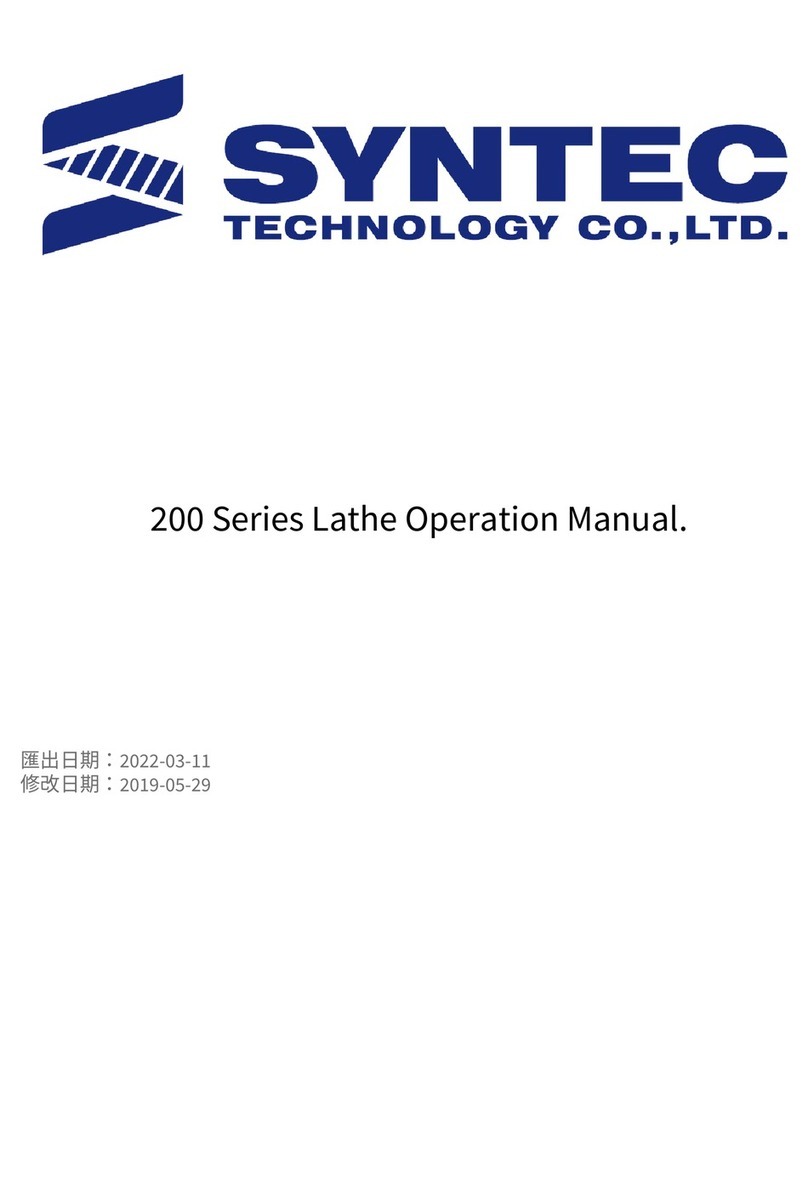
Syntec
Syntec 200 Series Operation manual
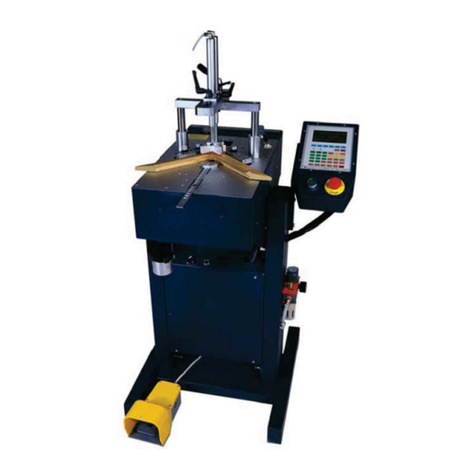
AMP
AMP Mitre-Mite VN4 MemoryProgram instruction manual

Rottler
Rottler SG9M Operation and maintenance manual

OPTIMUM Maschinen
OPTIMUM Maschinen OPTIturn TX 4414 operating manual
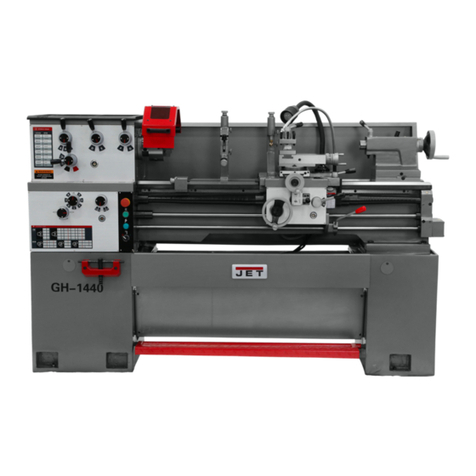
Jet
Jet GH-1440 Operating instructions and parts manual

Klutch
Klutch 49679 owner's manual

